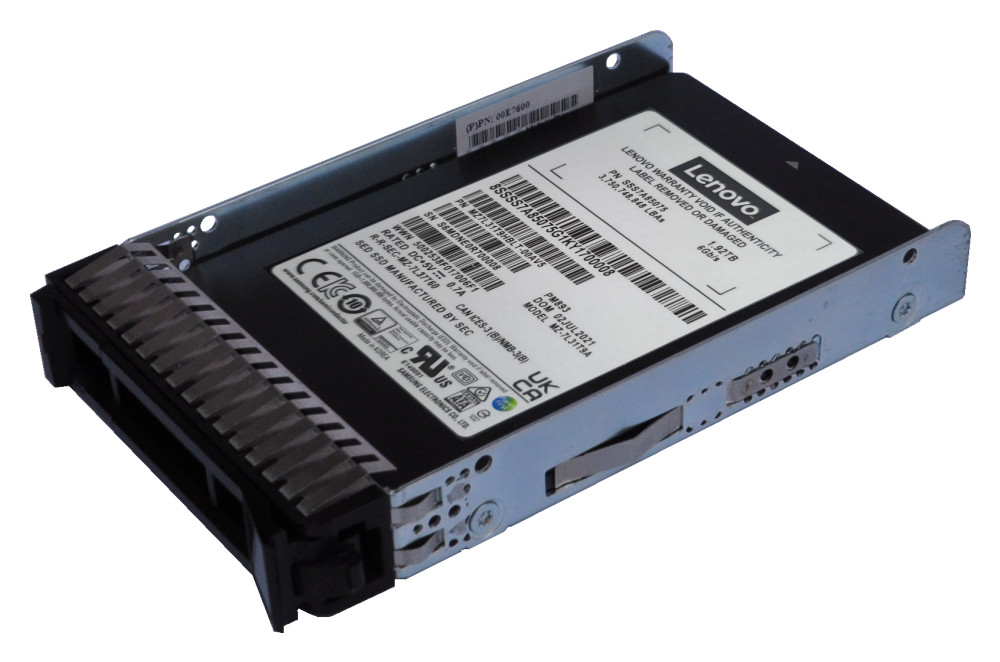Author
Published
29 Mar 2025Form Number
LP2191PDF size
15 pages, 223 KBAbstract
The ThinkSystem Vendor Agnostic Read Intensive SATA SSDs are general-purpose SSDs with an average endurance of 1 drive write per day. Vendor Agnostic SSDs are non-vendor-specific drives which can streamline and simplify the ordering and delivery of SATA SSDs. The drives offered in the Vendor Agnostic SSD program consists of SSDs that are readily available, ensuring the shortest supply lead time.
This product guide provides essential presales information to understand the Vendor Agnostic SSDs and their key features, specifications, and compatibility. This guide is intended for technical specialists, sales specialists, sales engineers, IT architects, and other IT professionals who want to learn more about the SSDs and consider their use in IT solutions.
Introduction
The ThinkSystem Vendor Agnostic Read Intensive SATA SSDs are general-purpose SSDs with an average endurance of 1 drive write per day. Vendor Agnostic SSDs are non-vendor-specific drives which can streamline and simplify the ordering and delivery of SATA SSDs. The drives offered in the Vendor Agnostic SSD program consists of SSDs that are readily available, ensuring the shortest supply lead time.
Figure 1. ThinkSystem Vendor Agnostic Read Intensive SATA SSDs
Did you know?
Lenovo Read Intensive SSDs are suitable for read-intensive and general-purpose data center workloads. Overall, these SSDs provide outstanding IOPS/watt and cost/IOPS for enterprise solutions and are an excellent choice for applications such as web serving, hyperscale cloud, content delivery, caching, databases, and analytics.
Part number information
The following table lists the part numbers and feature codes.
The part numbers include the following items:
- One 2.5-inch solid-state drive
- Hot-swap drives include either a 2.5-inch or 2.5-inch ThinkSystem hot-swap tray
- Non-hot-swap drives include a drive carrier
- Documentation flyer
Features
The Vendor Agnostic SSDs have the following features:
- Low cost SSD for read-intensive workloads from industry leading SSD vendors
- 6 Gbps SATA interface
- Advanced ECC Engine and End-to-End Data Protection
- TLC V-NAND stacks the vertical NAND layers in three dimensions, solving the cell-to-cell interference that causes data corruption in planar NAND.
- Power-loss protection (PLP) architecture
- Supports Self-Monitoring, Analysis and Reporting Technology (S.M.A.R.T).
Read-Intensive (Entry) SSDs and Write-Intensive (Performance) SSDs have similar read and write IOPS performance, but the key difference between them is their endurance (or lifetime) (that is, how long they can perform write operations because SSDs have a finite number of program/erase (P/E) cycles). Read-Intensive SSDs have a better cost/IOPS ratio but lower endurance compared to Write-Intensive SSDs. SSD write endurance is typically measured by the number of program/erase (P/E) cycles that the drive incurs over its lifetime, listed as the total bytes of written data (TBW) in the device specification.
The TBW value assigned to a solid-state device is the total bytes of written data (based on the number of P/E cycles) that a drive can be guaranteed to complete (% of remaining P/E cycles = % of remaining TBW). Reaching this limit does not cause the drive to immediately fail. It simply denotes the maximum number of writes that can be guaranteed. A solid-state device will not fail upon reaching the specified TBW. At some point based on manufacturing variance margin, after surpassing the TBW value, the drive will reach the end-of-life point, at which the drive will go into a read-only mode. Because of such behavior by Read-Intensive solid-state drives, careful planning must be done to use them only in read-intensive or mix-use up to 70% read/30% write environments to ensure that the TBW of the drive will not be exceeded before the required life expectancy.
Technical specifications
The following table lists the technical specifications of the ThinkSystem Vendor Agnostic Read Intensive SATA SSDs.
Performance and endurance values: The numbers listed in the table for performance and endurance are the minimums for Vendor Agnostic SSDs.
Server support
The following tables list the ThinkSystem servers that are compatible.
Operating system support
SAS and SATA SSDs operate transparently to users, storage systems, applications, databases, and operating systems.
Operating system support is based on the controller used to connect to the drives. Consult the controller product guide for more information:
- RAID controllers: https://lenovopress.com/servers/options/raid
- SAS HBAs: https://lenovopress.com/servers/options/hba
Warranty
The ThinkSystem Vendor Agnostic Read Intensive SATA SSDs carry a one-year, customer-replaceable unit (CRU) limited warranty. When the SSDs are installed in a supported server, these drives assume the system’s base warranty and any warranty upgrades.
Solid State Memory cells have an intrinsic, finite number of program/erase cycles that each cell can incur. As a result, each solid state device has a maximum amount of program/erase cycles to which it can be subjected. The warranty for Lenovo solid state drives (SSDs) is limited to drives that have not reached the maximum guaranteed number of program/erase cycles, as documented in the Official Published Specifications for the SSD product. A drive that reaches this limit may fail to operate according to its Specifications.
Physical specifications
The Vendor Agnostic SSDs have the following dimensions (without the hot-swap tray):
- Height: 7 mm (0.3 in.)
- Width: 70 mm (2.8 in.)
- Depth: 100 mm (4.0 in.)
Operating environment
The Vendor Agnostic SSDs are supported in the following environment:
- Temperature:
- Operating: 0 to 70 °C (32 to 158 °F)
- Non-operating: -40 °C to 85 °C (-40 to 185 °F)
- Relative humidity: 5 to 95% (noncondensing)
- Maximum altitude: 3,050 m (10,000 ft)
Agency approvals
The Vendor Agnostic SSDs conform to the following regulations:
- UL
- TUV
- FCC
- CE Mark
- C-Tick Mark
- BSMI (Taiwan)
- KCC (Korea EMI)
Related publications and links
For more information, see the following documents:
-
Lenovo ThinkSystem SSD Portfolio comparison:
https://lenovopress.com/lp1261-lenovo-thinksystem-ssd-portfolio - Lenovo RAID Introduction
https://lenovopress.com/lp0578-lenovo-raid-introduction
Trademarks
Lenovo and the Lenovo logo are trademarks or registered trademarks of Lenovo in the United States, other countries, or both. A current list of Lenovo trademarks is available on the Web at https://www.lenovo.com/us/en/legal/copytrade/.
The following terms are trademarks of Lenovo in the United States, other countries, or both:
Lenovo®
ThinkSystem®
The following terms are trademarks of other companies:
AMD is a trademark of Advanced Micro Devices, Inc.
Intel® is a trademark of Intel Corporation or its subsidiaries.
Other company, product, or service names may be trademarks or service marks of others.
Configure and Buy
Full Change History
Course Detail
Employees Only Content
The content in this document with a is only visible to employees who are logged in. Logon using your Lenovo ITcode and password via Lenovo single-signon (SSO).
The author of the document has determined that this content is classified as Lenovo Internal and should not be normally be made available to people who are not employees or contractors. This includes partners, customers, and competitors. The reasons may vary and you should reach out to the authors of the document for clarification, if needed. Be cautious about sharing this content with others as it may contain sensitive information.
Any visitor to the Lenovo Press web site who is not logged on will not be able to see this employee-only content. This content is excluded from search engine indexes and will not appear in any search results.
For all users, including logged-in employees, this employee-only content does not appear in the PDF version of this document.
This functionality is cookie based. The web site will normally remember your login state between browser sessions, however, if you clear cookies at the end of a session or work in an Incognito/Private browser window, then you will need to log in each time.
If you have any questions about this feature of the Lenovo Press web, please email David Watts at [email protected].

